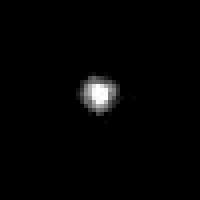20000 Varuna - Simple English Wikipedia, the free encyclopedia
 Hubble Space Telescope image of Varuna | |
| Discovery | |
|---|---|
| Discovered by | R. McMillan (Spacewatch) |
| Discovery date | 28 November 2000 |
| Designations | |
| MPC designation | 20000 Varuna |
| 2000 WR106 | |
| TNO (cubewano)[1] | |
| Orbital characteristics | |
| Epoch 14 July 2004 (JD 2453200.5) | |
| Aphelion | 6 781.985 Gm (45.335 AU) |
| Perihelion | 6 120.810 Gm (40.915 AU) |
| 6 451.398 Gm (43.129 AU) | |
| Eccentricity | 0.051 |
| 103 440.6 d (283.20 a) | |
Average orbital speed | 4.53 km/s |
| 89.673° | |
| Inclination | 17.2° |
| 97.296° | |
| 271.631° | |
| Physical characteristics | |
| Dimensions | 800 km (avg of thermals)[2] (scalene ellipsoid)?[3][4] |
| Mass | ≈3.7×1020? kg[3][5] |
Mean density | 0.992 g/cm³[3] |
| 0.15 m/s² | |
| 0.39 km/s | |
Sidereal rotation period | 0.132 16 d (3.17 h) |
| Albedo | 0.037–0.26[2] |
| Temperature | ≈43–41 K |
Spectral type | (moderately red) B-V=0.93 V-R=0.64[6] |
| 19.9 (opposition)[7] | |
| 3.7[8] | |
20000 Varuna is a big Kuiper belt object (KBO). It could be a dwarf planet. Before it was named Varuna, it had the provisional designation 2000 WR106.
Varuna is named after the Hindu deity Varuṇa.
Physical characteristics
[change | change source]Varuna completes one rotation in about 3.17 hours (or 6.34 hours, depending on whether the light curve is single or double-peaked). Given the fast rotation, which is not common for objects so big, Varuna is thought to be a stretched spheroid, with a density around 1g/cm³ (close to the density of water).[4]
The surface of Varuna is somewhat red and small amounts of water ice have been found on its surface.[9]
References
[change | change source]- ↑ Marc W. Buie (2007-01-12). "Orbit Fit and Astrometric record for 20000". SwRI (Space Science Department). Retrieved 2008-09-19.
- ↑ 2.0 2.1 Stansberry (2008). "TNO/Centaur diameters and albedos". Retrieved 2006-11-08.
- ↑ 3.0 3.1 3.2 Lightcurves Lacerda P., Jewitt D. Dentisities Of Solar System Objects From Their Rotational Lightcurves", accepted to AJ Dec. 2006 Preprint
- ↑ 4.0 4.1 Jewitt D, Sheppard S (2002). "Physical Properties Of Trans-Neptunian Object (20000) Varuna". Astronomical Journal. 123 (April): 2110–2120. doi:10.1086/339557. S2CID 16543165. Preprint on arXiv.
- ↑ Calculated using Lacerda and Jewitt (2007) diameter of 900 km and density of 0.992 g/cm³.
- ↑ "TNO and Centaur Colors". Archived from the original on 2006-09-08. Retrieved 2006-11-08.
- ↑ "HORIZONS Web-Interface". JPL Solar System Dynamics. Retrieved 2008-07-02.
- ↑ "JPL Small-Body Database Browser: 20000 Varuna (2000 WR106)". 2007-11-17. Retrieved 2008-07-02.
- ↑ Licandro J, Oliva E, Di Martino M (2001). "NICS-TNG infrared spectroscopy of trans-neptunian objects 2000 EB173 and 2000 WR106". Astronomy & Astrophysics. 373 (July): 29–32L. doi:10.1051/0004-6361:20010758. S2CID 15690206.
{{cite journal}}: CS1 maint: multiple names: authors list (link)
Other websites
[change | change source]- "Size and Albedo of Kuiper Belt Object (20000) Varuna". David Jewitt's Home Page. Retrieved 2005-08-15. Site updated Reretrived on 2006-07-10
- Orbital simulation from JPL (Java) / Ephemeris


 French
French Deutsch
Deutsch